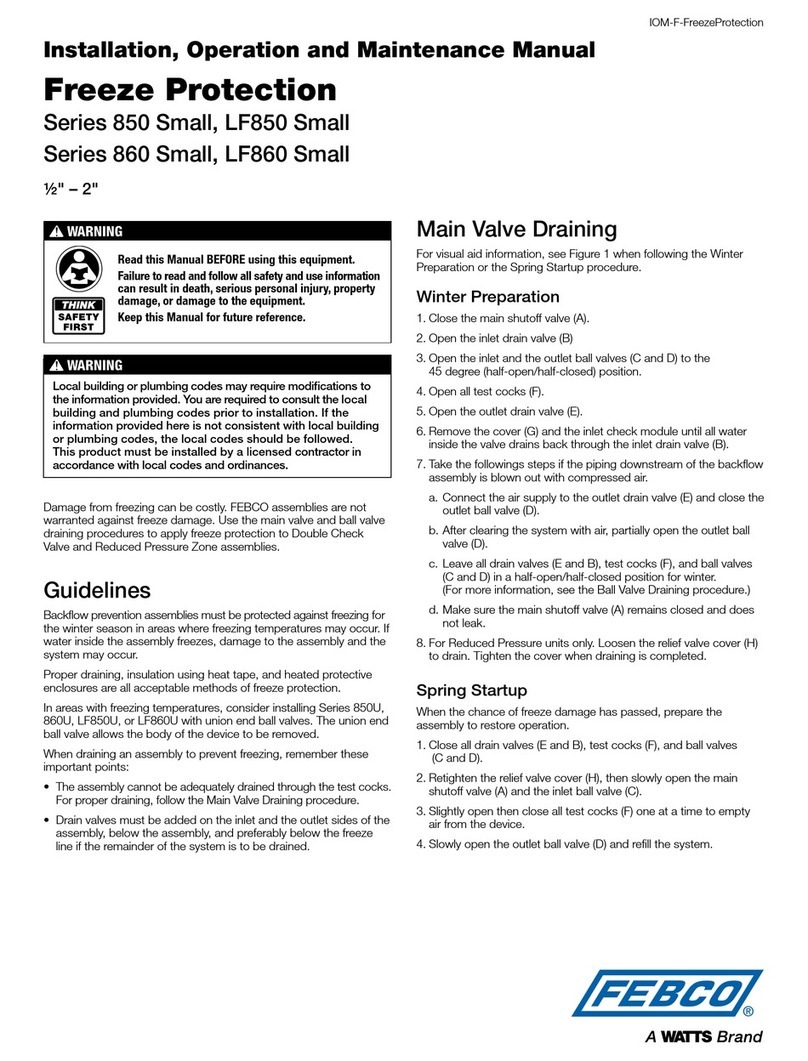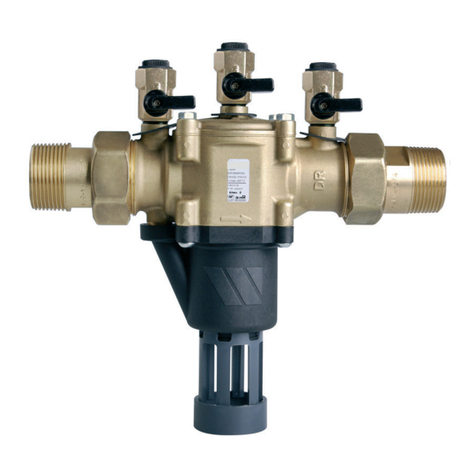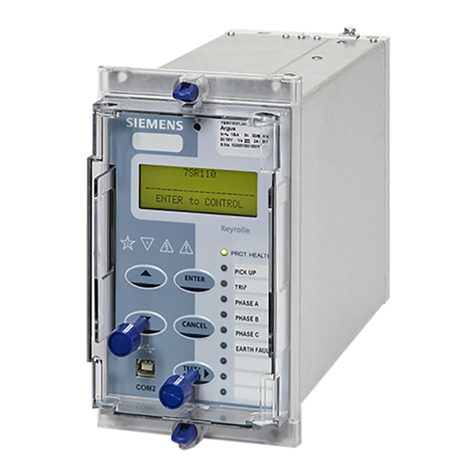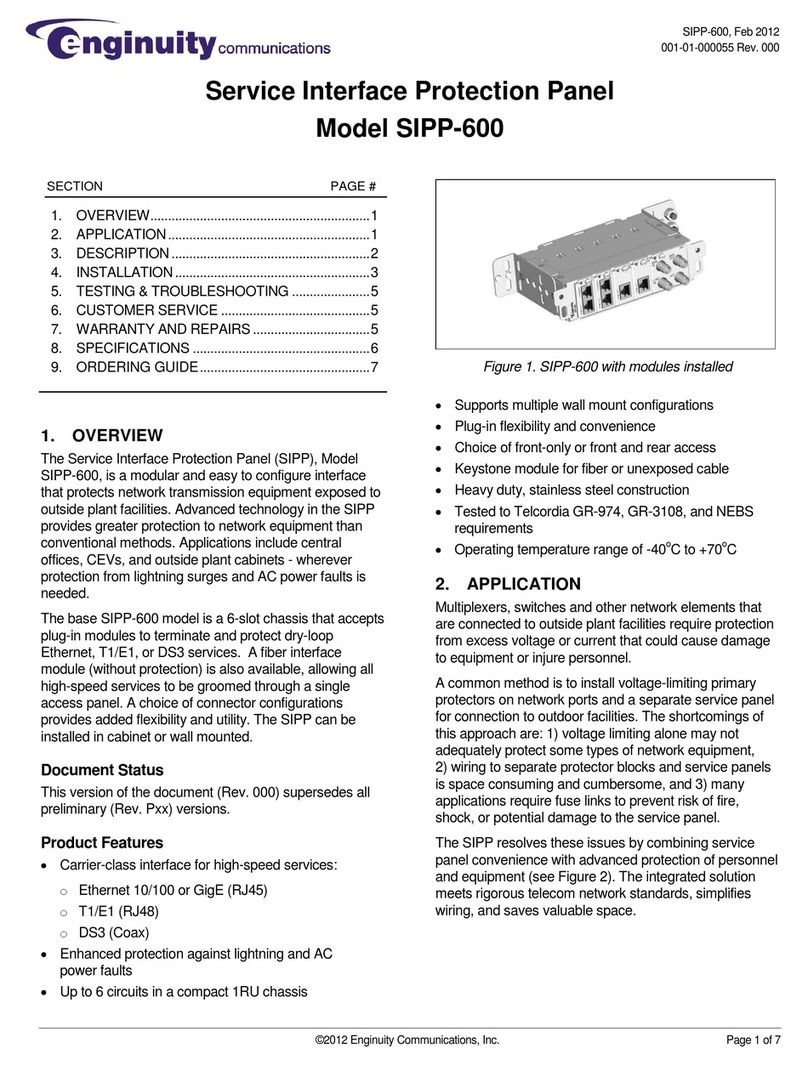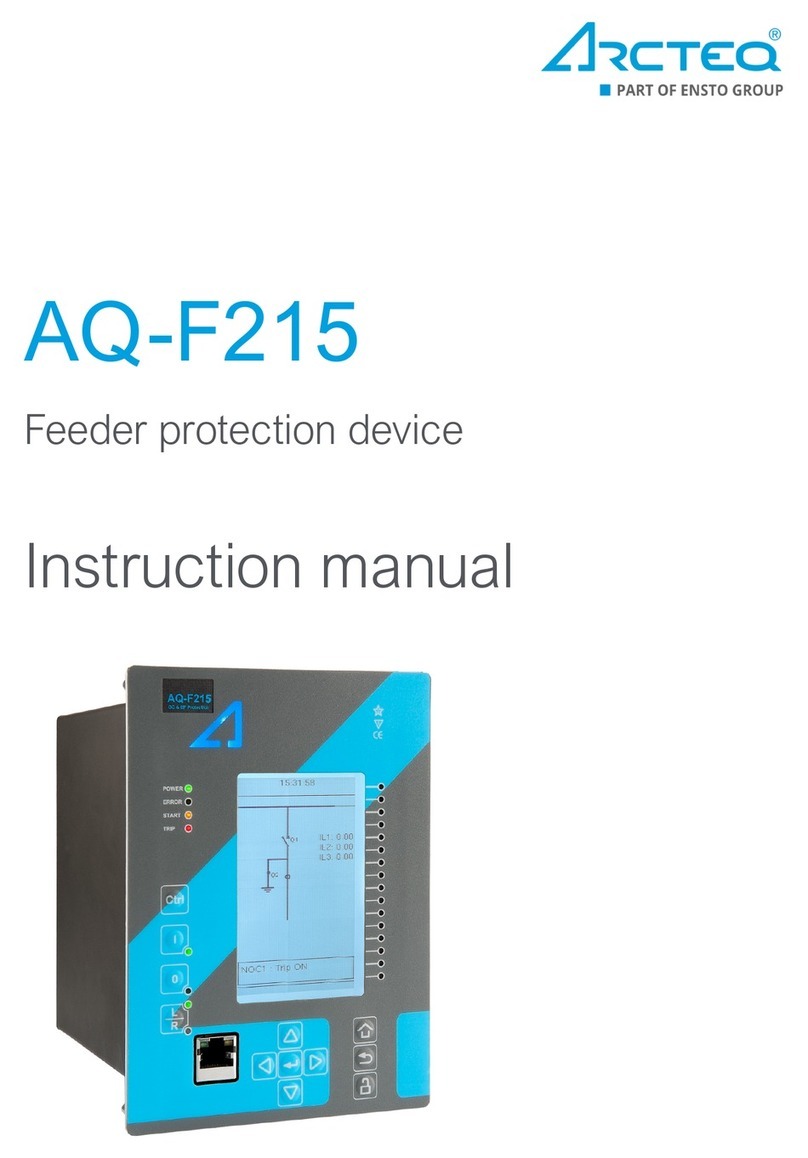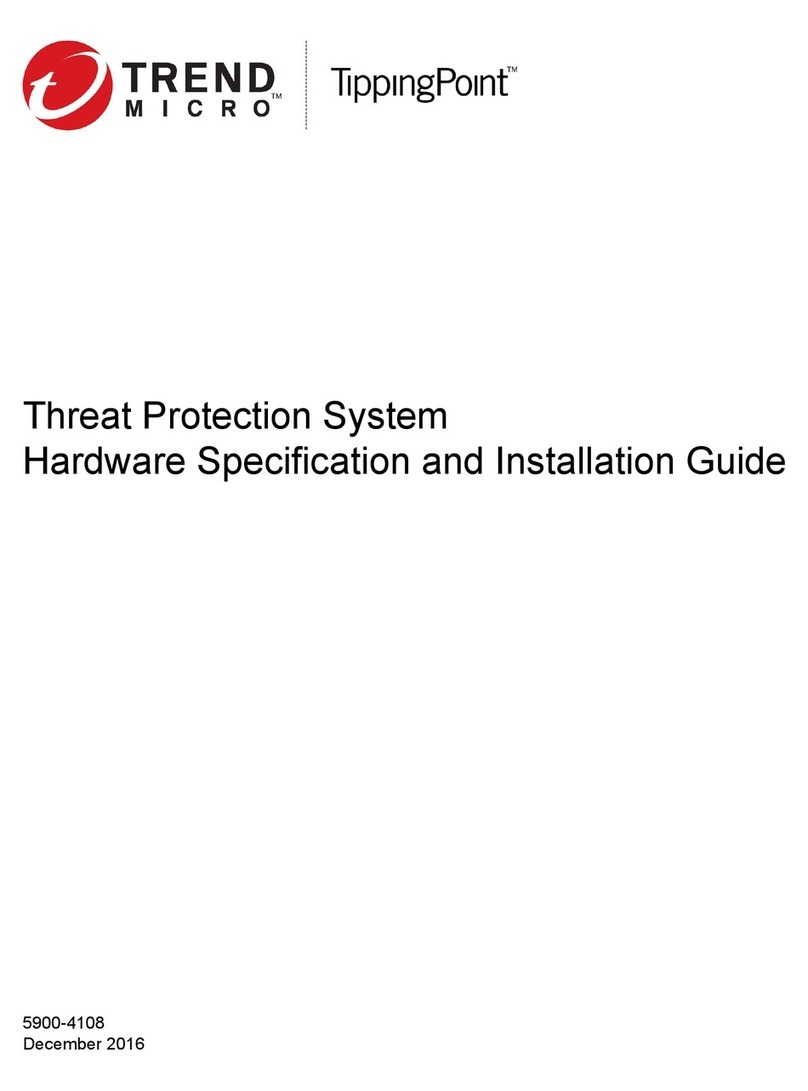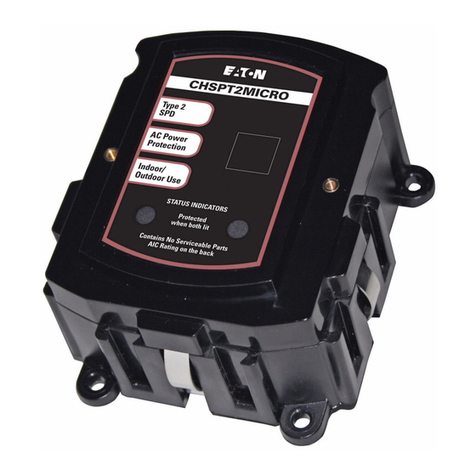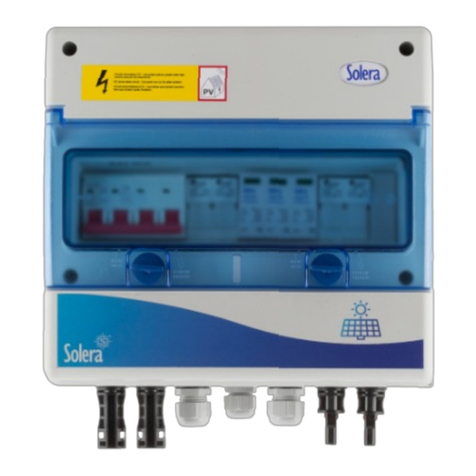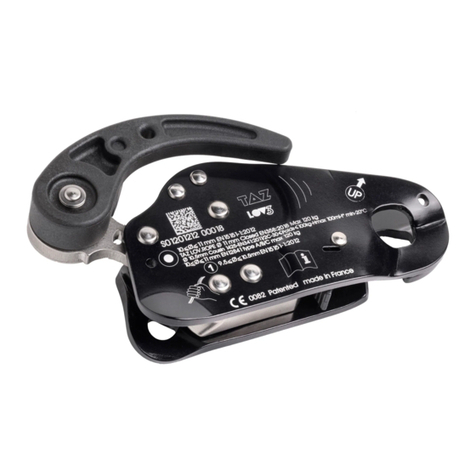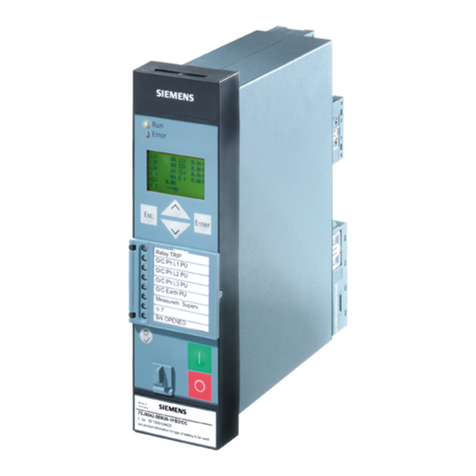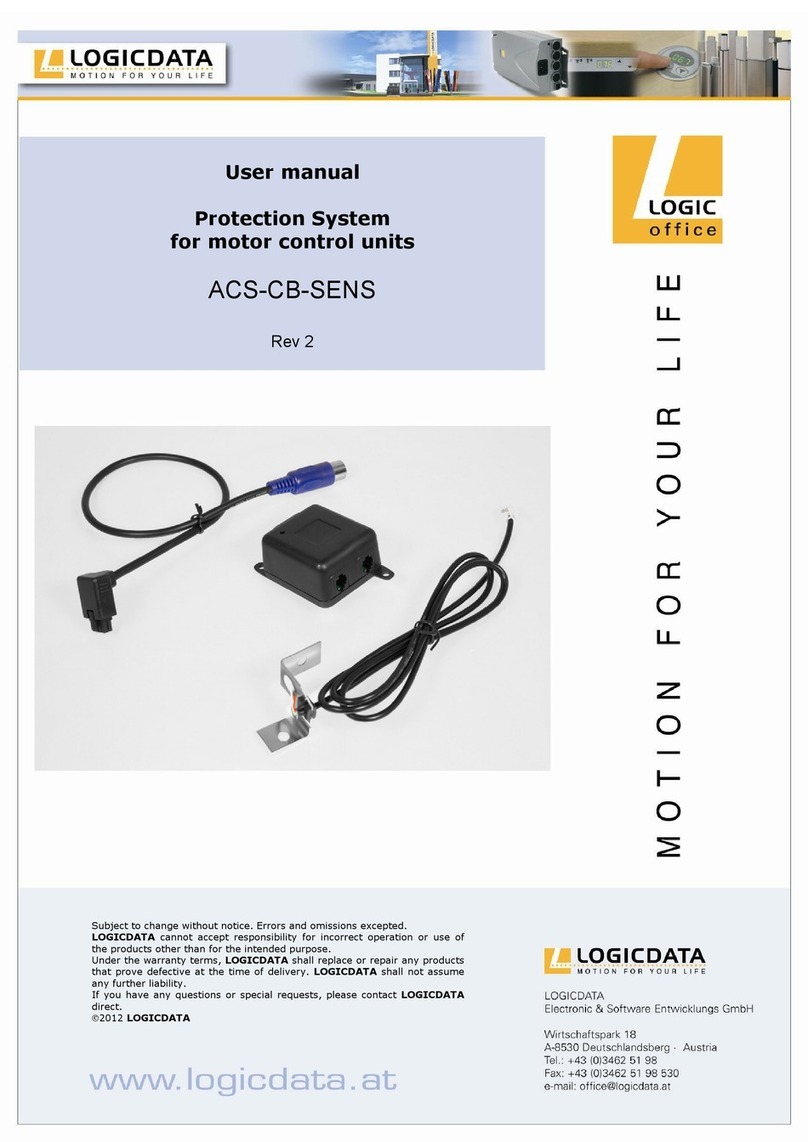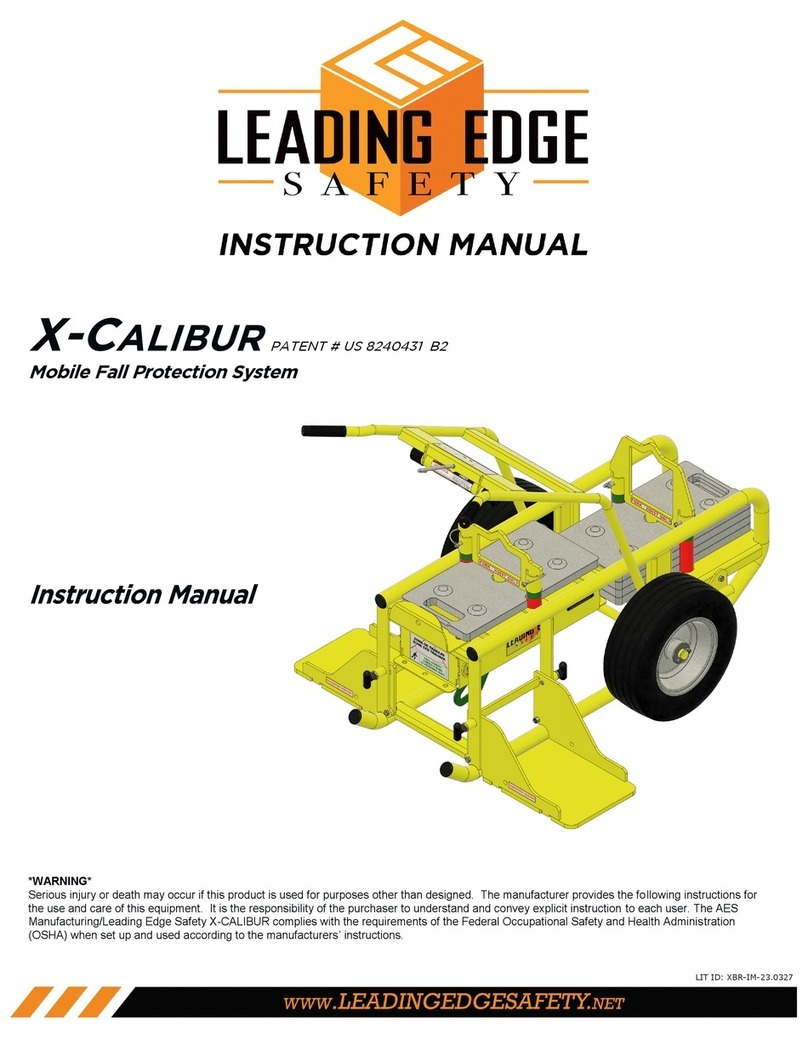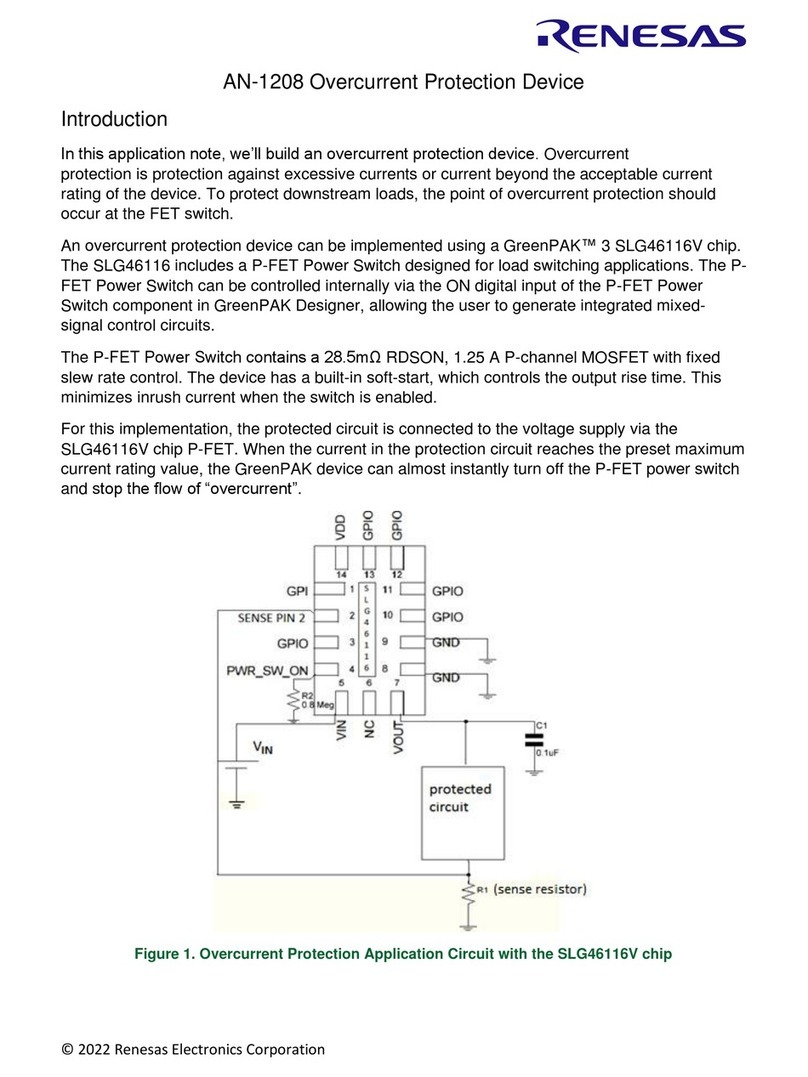Watts LFM116-52 Installation and operating instructions

Installation, Operation and Maintenance
Pressure Relief and Surge Anticipator Control Valve
Sizes: 1¼" to 24"
NOTICE
For Australia and New Zealand: Pipeline strainers should be
installed between the upstream shutoff valve and the inlet of
the backflow preventer.
It’s important that this device be tested periodically in compli-
ance with local codes, but at least once per year or more as
service conditions warrant. If installed on a fire sprinkler system,
all mechanical checks, such as alarm checks and backflow
preventers, should be flow tested and inspected internally in
accordance with NFPA 13 and NFPA 25.
WARNING
!
Read this Manual BEFORE using this equipment.
Failure to read and follow all safety and use information
can result in death, serious personal injury, property
damage, or damage to the equipment.
Keep this Manual for future reference.
Table of Contents Page
Introduction............................................2
Installation ............................................2
Setting the Pressure Controls .............................3
Maintenance Schedule...................................6
Trouble Shooting Guide ..................................6
Valve Disassembly Instructions ........................ 8
ACV Schematic .......................................11
Local building or plumbing codes may require modifica-
tions to the information provided. You are required to
consult the local building and plumbing codes prior
to installation. If the information provided here is not
consistent with local building or plumbing codes, the
local codes should be followed. This product must be
installed by a licensed contractor in accordance with
local codes and ordinances.
WARNING
!
Need for Periodic Inspection/Maintenance: This product
must be tested periodically in compliance with local codes,
but at least once per year or more as service conditions
warrant. All products must be retested once maintenance
has been performed. Corrosive water conditions and/or
unauthorized adjustments or repair could render the product
ineffective for the service intended. Regular checking and
cleaning of the product’s internal and external components
helps assure maximum life and proper product function.
WARNING
!
psi
AVOIDFREEZING
R
100
140
120
160
190
200
80
60
40
20
Model LFM116-52/LFM6116-52
IOM-ACV-116-52_6116-52

Standard Components
Operation
The Combination Surge Anticipator and Pressure Relief Automatic
Control Valve (ACV) is designed to minimize the effects of water
hammer and pressure surges resulting from: 1) Normal pump start-
ing and stopping operations or 2) Mechanical or electrical power
failure situations. The valve senses hydraulic pressure changes
directly from the pump station discharge header, and opens to
relieve pipeline surges when pump station discharge header pres-
sure falls below the adjustable spring setting of the low pressure
opening pilot OR exceeds the adjustable spring setting of the high
pressure relief pilot. These two pressure conditions occur during
normal pump starting and stopping operations or when an active
pumping cycle is interrupted by electrical or mechanical failure.
1
X X
X
7A 7B
5
4
3
6
9
2
P(L)
8
CLOSES VALVE
OPENS VALVE
FLOW
X / Y
Supply
Pressure
1. Clear the line free of slag and other debris.
2. Install the valve so that the FLOW ARROW marked on the valve body/tag corresponds to flow through the line.
3. Close upstream and downstream isolation valves.
4. Open the ball valves or isolation cocks in the control tubing if so equipped. Failure to open these will prevent the valve from func-
tioning properly.
Start-up of an automatic control valve requires that proper procedures be followed. Time must be allowed for the valve to react to
adjustments and the system to stabilize. The objective is to bring the valve into service in a controlled manner to protect the system
from damaging over-pressure.
High Pressure Relief Operation: When discharge header pressure exceeds the adjustable setpoint, the high pressure relief pilot
opens, venting main valve cover pressure downstream, causing the valve to quickly open and dissipate the high pressure surge. When
discharge header pressure falls below the adjustable setpoint, the high-pressure relief pilot closes, allowing pressure to fill the main
valve cover chamber, slowly closing the valve. This condition occurs during normal pump starting and stopping operations.
Low Pressure Opening Operation (Surge Anticipation): When discharge header pressure falls below the adjustable setpoint, the
low-pressure pilot opens and the drain pilot closes, "storing" main valve cover pressure in the hydraulic accumulator. The main valve
opens at an adjustable rate in anticipation of the returning high-pressure wave. This condition occurs during a mechanical or electrical
power failure situation.
Valve Closing: When discharge header pressure recovers above the adjustable setpoint, the low-pressure pilot closes, allowing header
pressure to fill the main valve cover chamber. The main valve closes at an adjustable rate to avoid creating additional pressure surges.
The accumulator drain pilot opens, releasing the "stored" main valve cover pressure.
If discharge header pressure does not "recover" above the low-pressure opening setpoint, the "stored" pressure in the hydraulic accu-
mulator allows the main valve to close, avoiding system siphonage or draining the pumping system.
1 – Main Valve (M100 – Single Chamber)
2 – Adjustable Closing Speed
3 – Adjustable Opening Speed
4 – Pressure Relief Control
5 – Low Pressure Control
6 – Accumulator Drain Valve
7 – Test Valves
8 – Pressure Gauge
9 – Hydraulic Accumulator
P – Position Indicator
Y – Y-Strainer
X – Isolation Cocks
Installation
LFM116-52 (Globe) Pressure Relief and Surge Anticipator
Control Valve
2 IOM-ACV-116-52_6116-52 2115 EDP# 1917053 © 2021 Watts

STEP 1
Pre-set pilots as noted:
Low Pressure Control – Adjust OUT, counterclockwise, allowing the valve to be brought up to the desired pressure in a controlled
manner.
Relief Control – Turn the adjustment screw OUT, clockwise, backing pressure off the spring, allowing valve to be brought up to the
desired high pressure in a controlled manner.
Opening and Closing Speed – Turn the adjustment screws on the Closing Speed and Opening Speed Controls, if the main valve is so
equipped, OUT, counterclockwise, 1½ to 2½ turns from full closed position.
STEP 2
To ensure proper operation, any trapped air will need to be bled off
the valve cover during startup. If your ACV includes a bleed valve,
use a flat head screwdriver to slowly open the valve (Figure 1).
If your valve does not include a bleed valve, bleed air by loosen-
ing a fitting on the valve or a plug, at the highest point of the valve
assembly.
STEP 3
Pressure the line, by opening the upstream isolation valve slowly
Air is vented through the air bleed valve or loosened fitting.
Tighten the fitting when liquid begins to vent (See Figure 1).
Repeat the process until no air is trapped in the system.
Globe
Angle
Size (in) 1¼ 1½ 2 2½ 3 4 6 8 10 12 14 16 20 24
A (in) 16 16 20 22 22 24 32 34 38 44 48 52 56 56
B (in) 10 10 12 14 14 16 24 26 28 30 34 40 48 48
Size (in) 1¼ 1½22½ 3 4 6 8 10 12 14 16
C (in) 16 16 20 22 22 24 32 34 38 44 48 52
D (in) 10 10 12 14 14 16 24 26 28 30 34 40
Counterclockwise to OPEN
bleed valve
Setting the Pressure Controls
The following tables detail the recommended minimum valve servicing dimensions.
A
B
C
FLOW FLOW
FLOW
D
FLOW
Valve Servicing Dimensions
Figure 1
Position Indicator
IOM-ACV-116-52_6116-52 2115 EDP# 1917053 © 2021 Watts 3

Setting the High Pressure
Relief Control
STEP 4
Slowly open downstream isolation valve to establish flow through
the system.
STEP 5
With pump operating, throttle a downstream isolation valve
closed.
STEP 6
Adjust the Relief Control adjustment screw IN, clockwise, until the
inlet pressure rises to the desired high pressure relief setting (See
Figure 2).
4 IOM-ACV-116-52_6116-52 2115 EDP# 1917053 © 2021 Watts IOM-ACV-116-52_6116-52 2115 EDP# 1917053 © 2021 Watts 5
Figure 2
PV20C — Pressure Sustaining Control
Clockwise to increase inlet
pressure
Counterclockwise to decrease
inlet pressure

Setting the Low Pressure
Control
STEP 7
Close test valve 7A (See Figure 3) and use test valve 7B to reduce
gauge pressure to the desired low pressure tip point. (typically
10-20 PSI below static line pressure).
Clockwise to CLOSE
Test Valve
Counterclockwise to INCREASE
the rate of opening
Clockwise to DECREASE
rate of opening
STEP 8
Slowly turn the 263 Low Pressure Control (See Figure 4) adjust-
ment screw IN, clockwise, until the main valve starts to open. This
setting can be confirmed by opening the test valve 7A, which will
raise the gauge pressure, then slowly lowering the gauge pressure
using test valve 7B until the main valve starts to open. When the
low pressure control is finally set, ensure that test valve 7A is left
fully open.
STEP 9
Once the approximate time for the pressure wave to return has
been calculated, the main valve can be cycled using test valves
and the opening speed adjusted such that the main valve will be
open before the wave arrives. The closing speed control (See
Figure 5) should be adjusted so that the main valve will not com-
mence closing until after the wave has passed. Closing speed
should not be so rapid that main valve closure itself creates sig-
nificant line shock.
Figure 5
Flow Control
4 IOM-ACV-116-52_6116-52 2115 EDP# 1917053 © 2021 Watts IOM-ACV-116-52_6116-52 2115 EDP# 1917053 © 2021 Watts 5
Figure 3
Test Cock
Counterclockwise to CLOSE
main valve
Clockwise to OPEN
main valve
Figure 4
263RS - Low Pressure Control
7A
7B

To ensure peak performance and longevity of your automatic
control valve, Watts/Ames recommends following the below
standard maintenance schedule.
• Monthly Maintenance
– Visual inspection of valve(s) for leaks
– Inspect for proper operation(s); exercise valve.
• Quarterly Maintenance
– Conduct monthly inspection.
– Validate/Re-establish necessary setpoints of controls/pilots.
• Annual Maintenance
– Conduct monthly & quarterly inspections.
– Inspect & clean all strainers.
– Inspect valve coating, touch up as required.
• 3-5 Year Maintenance
– Conduct monthly, quarterly, & annual maintenance.
– Inspect & replace valve elastomers (diaphragm, O-rings,
valve/pilot seats)
– Re-establish necessary set points of controls/pilots.
Automatic Control Valve Maintenance Schedule
Troubleshooting Guide
Warning: The valve cannot be serviced under pressure.
Upstream and downstream Isolation Valves must be installed
to protect system piping. Accurate diagnosis and trouble-
shooting requires the valve to open fully, and may subject
downstream piping and equipment to high pressure and/or
flow rates. The downstream Isolation Valve should be kept
closed while diagnosing the valve.
Extreme caution should be used while performing the
troubleshooting techniques listed below.
WARNING
!
Recommended tools for diagnosis: (3) PRESSURE GAUGES,
installed to monitor the inlet pressure, outlet pressure, and cover
chamber pressure. If included, a POSITION INDICATOR should
be installed to visually assess the position of the disc &
diaphragm assembly.
Test 1: Diaphragm Seal Test
1. Close upstream & downstream isolation valves. Close pilot
isolation valves or remove pilot control tubing to isolate valve
cover from incoming fluid & pressure. Remove uppermost
cover plug, test cock, or limit switch.
2. With the valve cover chamber vented to atmosphere,
partially open the upstream isolation valve, allowing incoming
pressure to lift the disc & diaphragm assembly. A volume of
water will be displaced from the cover chamber as the valve
opens; consult valve specification sheets for approximate
cover capacity. A continuous flow of water from the open port
indicates a damaged diaphragm or loose disc & diaphragm
assembly. Disassemble valve and replace diaphragm or tighten
disc & diaphragm assembly.
Test 2: Seat Seal Test
1. Close downstream isolation valve and install pressure gauges
on an open inlet and outlet port of main valve.
2. Open upstream isolation valve to allow pressure on to the
valve cover. Allow valve to fully close.
3. Monitor downstream pressure gauge; reading should hold
steady below incoming pressure. If pressure on downstream
side rises to match upstream pressure, leakage is occurring
through the seat of the main valve. Disassemble valve, inspect
and repair/replace any required parts.
a. If gauge pressure rises to match outlet pressure (down-
stream of closed isolation valve) yet remains below inlet
pressure, the isolation valve may be leaking as opposed to
main valve seat.
Test 3: Freedom of Movement/Valve
Travel Test
1. Close upstream and downstream isolation valves. Install valve
position indicator.
2. Partially open upstream isolation valve and allow cover to fill
with fluid & pressure, closing the valve fully. Mark the position
indicator’s full closed position.
3. Isolate cover chamber from receiving fluid and pressure by
closing isolation valves or removing control tubing.
4. Carefully vent cover chamber to atmosphere by opening test
cock or removing a cover plug. Observe the valve position
indicator as the valve travels to the full-open position. The disc
& diaphragm assembly should move freely from fully closed to
fully open position without binding or “grabbing” at any point
during its movement.
a. The disc & diaphragm assembly may momentarily “hesi-
tate” while travelling from fully closed to fully open position
– this is a normal characteristic of diaphragm operated
control valves, and does not indicate mechanical binding
or improper valve operation.
b. A continuous discharge of water from the cover chamber
after venting to atmosphere indicates leakage past the
diaphragm.
5. If necessary, disassemble valve and inspect/repair disc &
diaphragm assembly.
6 IOM-ACV-116-52_6116-52 2115 EDP# 1917053 © 2021 Watts IOM-ACV-116-52_6116-52 2115 EDP# 1917053 © 2021 Watts 7

Issue Possible Cause Corrective Action Notes
Main Valve will not
open
Closed isolation valves in pilot system. Check isolation valves, ensure
open.
Insufficient supply pressure. Check upstream pressure. Depending on water
source, supply pressure
may not be controlled by
valve operator.
Main valve stem assembly corroded/
damaged.
Inspect stem assembly, clean/
replace if necessary.
Blockage in pilot system. Inspect & clean any installed
pilot system strainers, check
orifice/speed controls for
blockages.
Missing fixed orifice assembly. Verify installation of orifice;
replace if required/missing.
Pilot valve inlet isolation
valve can be used as a
makeshift orifice assembly
by partially opening from
full closed position.
Improperly configured opening speed
control (if equipped).
Adjust opening speed control
to verify functionality, adjust as
required.
Standard setting for
opening speed control is
1½ - 2½ turns open from
full closed position. Can
be adjusted in field.
Main Valve will not
close
Closed isolation valves in pilot system Check isolation valves, ensure
open.
Diaphragm is damaged Conduct diaphragm seal test,
repair and replace if necessary.
Main valve stem assembly corroded/
damaged.
Inspect stem assembly, clean/
replace if necessary.
Blockage in main valve. Perform freedom of movement
test; if valve does not close,
disassemble and remove
blockage.
Worn/damaged valve seat. Perform seat sealing check;
disassemble and inspect/repair
seat if required.
Troubleshooting Guide
6 IOM-ACV-116-52_6116-52 2115 EDP# 1917053 © 2021 Watts IOM-ACV-116-52_6116-52 2115 EDP# 1917053 © 2021 Watts 7

Valve Disassembly Instructions
Before undertaking valve disassembly, it is recommended to gather the following tools to aid you during the process:
• Small & large adjustable wrenches
• Screwdriver set
• Machinist fine metal file
• Fine wire brush
• Bench vise
• Basic valve IO&M manual
• Hammer & dull cold chisel
• Heavy-duty ratchet & socket set
• Hexagonal wrench set
• 320 grit/fine Emery cloth
• Appropriate technical bulletins for
valve start-up procedures.
1. Isolate the valve from line pressure and depressurize it to ensure safe working conditions. Disconnect any electrical
connections if so equipped.
2. Carefully remove Position Indicator or Limit Switches if equipped. Remove all tubing, fittings, and Control Pilots
necessary to easily access and remove the cover. Remove cover nuts and washers.
3. Remove the cover. If cover is not free to be removed, loosen it by tapping upward along its outside edge with a dull cold chisel, pic-
tured above.
a. Large valves may require the installation of lifting “eye” bolts in order to facilitate cover removal; installation ports are provided on
the cover for this purpose.
4. Remove the Disc and Diaphragm Assembly from the valve body by lifting straight up.
a. Large diameter valves may require a lifting “eye” bolt to be installed in the valve stem accessory threads located on the very
top of the valve stem.
5. Before removing Stem Nut, examine stem threads for mineral build-up. Remove deposits with a fine wire brush. Extreme care should
be taken not to damage the finish on stem guiding surfaces when disassembling. Avoid applying pipe wrenches to top or bottom
stem guide surfaces.
VALVE COVER
BRASS BAR STOCK
(ANGLE UPWARD)
HAMMER
8 IOM-ACV-116-52_6116-52 2115 EDP# 1917053 © 2021 Watts

Size A B C D E (Dia.) F
in Pipe Size (in) Min. Length (in) in in in in
1¼ 1 3.12 0.38 0.25 0.44 0.55
1½ 1 3.12 0.38 0.25 0.44 0.50
2 1¼3.38 0.38 0.25 0.44 0.50
2½ 2 4.0 0.38 0.38 0.56 0.62
3 2½4.5 0.50 0.38 0.56 0.62
4 3 5.0 0.50 0.44 0.56 0.62
6 5 6.50 0.62 0.44 0.56 0.62
6. After removing the Stem Nut, the remainder of the Disc & Diaphragm Assembly should disassemble easily. Polish stem guide
surfaces with fine emery cloth to remove any mineral deposits and inspect for excessive wear. Remove any mineral build-up from
other components with wire brush or by using a Mineral Dissolving Solution. Inspect parts for wear and replace if necessary.
7. Inspect valve seat. If seat is not damaged, removal is not necessary. Valve seats 6" and smaller are threaded into the body of the
valve and require a seat removal tool (Figure 6) (Table 1 details the tool dimensions for seat removal). Valve seats 8" and larger are
held in the valve body with stainless steel cap screws. Remove seat retaining screws and lift seat straight up (Figure 7).
Figure 7
*Schedule 40 steel pipe
Figure 6
Valve Body
Valve Seat
All-Thread
Nut and Washer
2PLCS
Angle or
Channel Iron
120
B (Min)
E Dia. 4 Holes
90 Apart
D
TYP <3 PLCS>
120 Apart
C TYP <3 PLCS>
F
A
Table 1: Seat Removal Tool Dimension
IOM-ACV-116-52_6116-52 2115 EDP# 1917053 © 2021 Watts 9

Size (in) 3 4 6 8 10 12 16 20 & 24
P/N 0677-01 0677-01 0677-02 0677-03 0677-04 0677-05 0677-09 0677-11
8. Replace Seat Disc, Diaphragm and Spacer Washers provided in Main Valve repair kit (refer to Table 2 or 3 for correct repair kit part
number). Re-assemble in the reverse order of disassembly.
9. Re-Install Disc and Diaphragm Assembly in the valve, taking care not to damage the lower guide area in the center of the valve
seat.
10. Re-install Cover Spring. Replace Valve Cover and tighten Cover Nuts in a crossing pattern to ensure even distribution. Test the Disc
and Diaphragm Assembly for smooth travel by following the Freedom of Movement Test procedure in previous section.
11. Test the integrity of the Seat Seal by following the Seat Seal Test procedure in previous section.
12. Return valve to service by following instructions on the Technical Bulletin matching the valve function.
Size (in) 1¼ 1½22½ 3 4 6 8 10 12 14 16
P/N 0677-01 0677-01 0677-02 0677-03 0677-04 0677-05 0677-06 0677-07 0677-08 0677-09 0677-10 0677-11
10 IOM-ACV-116-52_6116-52 2115 EDP# 1917053 © 2021 Watts IOM-ACV-116-52_6116-52 2115 EDP# 1917053 © 2021 Watts 11
Table 2: Full Port Valve (M100/M1100) Repair Kits
Table 3: Reduced Port Valve (M6100 / M61100) Repair Kits

Optional
Xylan
Coating
17A
6
1
2
3
4
5
7
8
9
11
12
13
14
15
16
17
18
10
10 IOM-ACV-116-52_6116-52 2115 EDP# 1917053 © 2021 Watts IOM-ACV-116-52_6116-52 2115 EDP# 1917053 © 2021 Watts 11
ACV Assembly Diagram – Series LFM116-52
Item Description Material
1Pipe Plug Lead Free Brass
2Cover ASTM A536 65-45-12 Epoxy Coated Ductile Iron
3Cover Bearing ASTM A276 304 Stainless Steel
4Stud with Cover Nut and Washer ASTM A570 Gr.33 Zinc Plated Steel
5Body ASTM A536 65-45-12 Epoxy Coated Ductile Iron
6Spring ASTM A276 302 Stainless Steel
7Stem Nut ASTM A276 304 Stainless Steel
8Lock Washer ASTM A276 304 Stainless Steel
9Stem Washer ASTM A276 304 Stainless Steel
10 Diaphragm Washer ASTM A536 65-45-12 Epoxy Coated Ductile Iron
11 Diaphragm* Buna-N (Nitrile)
12 Disc Retainer ASTM A536 65-45-12 Epoxy Coated Ductile Iron
13 Seat Disc* Buna-N (Nitrile)
14 Spacer Washer* x5 NY300 Fiber*
15 Disc Guide ASTM A743 CF8M (316) Stainless Steel
16 Shaft ASTM A276 304 Stainless Steel
17 Seat Ring** ASTM A743 CF8M (316) Stainless Steel
17A Seat Screw** (8" and Larger) ASTM A276 304 Stainless Steel
18 Seat Gasket* Buna-N (Nitrile)
* Contained in Main Valve Repair Kit
**Note: 6 inch and Smaller Valves, Seat Ring is threaded
Installation: If unit is installed in any orientation other than
horizontal (cover up) OR extreme space constraints exist,
consult customer service prior to or at the time of order.
NOTICE

IOM-ACV-116-52_6116-52 2115 EDP# 1917053 © 2021 Watts
USA: T: (978) 689-6066 • F: (978) 975-8350 • Watts.com
Canada: T: (888) 208-8927 • F: (905) 481-2316 • Watts.ca
Latin America: T: (52) 55-4122-0138 • Watts.com
Limited Warranty: Watts Regulator Co. (the “Company”) warrants each product to be free from defects in material and workmanship under normal usage for a period of one year from the date of
original shipment. In the event of such defects within the warranty period, the Company will, at its option, replace or recondition the product without charge.
THE WARRANTY SET FORTH HEREIN IS GIVEN EXPRESSLY AND IS THE ONLY WARRANTY GIVEN BY THE COMPANY WITH RESPECT TO THE PRODUCT. THE COMPANY MAKES NO OTHER
WARRANTIES, EXPRESS OR IMPLIED. THE COMPANY HEREBY SPECIFICALLY DISCLAIMS ALL OTHER WARRANTIES, EXPRESS OR IMPLIED, INCLUDING BUT NOT LIMITED TO THE IMPLIED
WARRANTIES OF MERCHANTABILITY AND FITNESS FOR A PARTICULAR PURPOSE.
The remedy described in the first paragraph of this warranty shall constitute the sole and exclusive remedy for breach of warranty, and the Company shall not be responsible for any incidental, special
or consequential damages, including without limitation, lost profits or the cost of repairing or replacing other property which is damaged if this product does not work properly, other costs resulting
from labor charges, delays, vandalism, negligence, fouling caused by foreign material, damage from adverse water conditions, chemical, or any other circumstances over which the Company has no
control. This warranty shall be invalidated by any abuse, misuse, misapplication, improper installation or improper maintenance or alteration of the product.
Some States do not allow limitations on how long an implied warranty lasts, and some States do not allow the exclusion or limitation of incidental or consequential damages. Therefore the above
limitations may not apply to you. This Limited Warranty gives you specific legal rights, and you may have other rights that vary from State to State. You should consult applicable state laws to
determine your rights. SO FAR AS IS CONSISTENT WITH APPLICABLE STATE LAW, ANY IMPLIED WARRANTIES THAT MAY NOT BE DISCLAIMED, INCLUDING THE IMPLIED WARRANTIES OF
MERCHANTABILITY AND FITNESS FOR A PARTICULAR PURPOSE, ARE LIMITED IN DURATION TO ONE YEAR FROM THE DATE OF ORIGINAL SHIPMENT.
This manual suits for next models
1
Table of contents
Other Watts Protection Device manuals
Popular Protection Device manuals by other brands
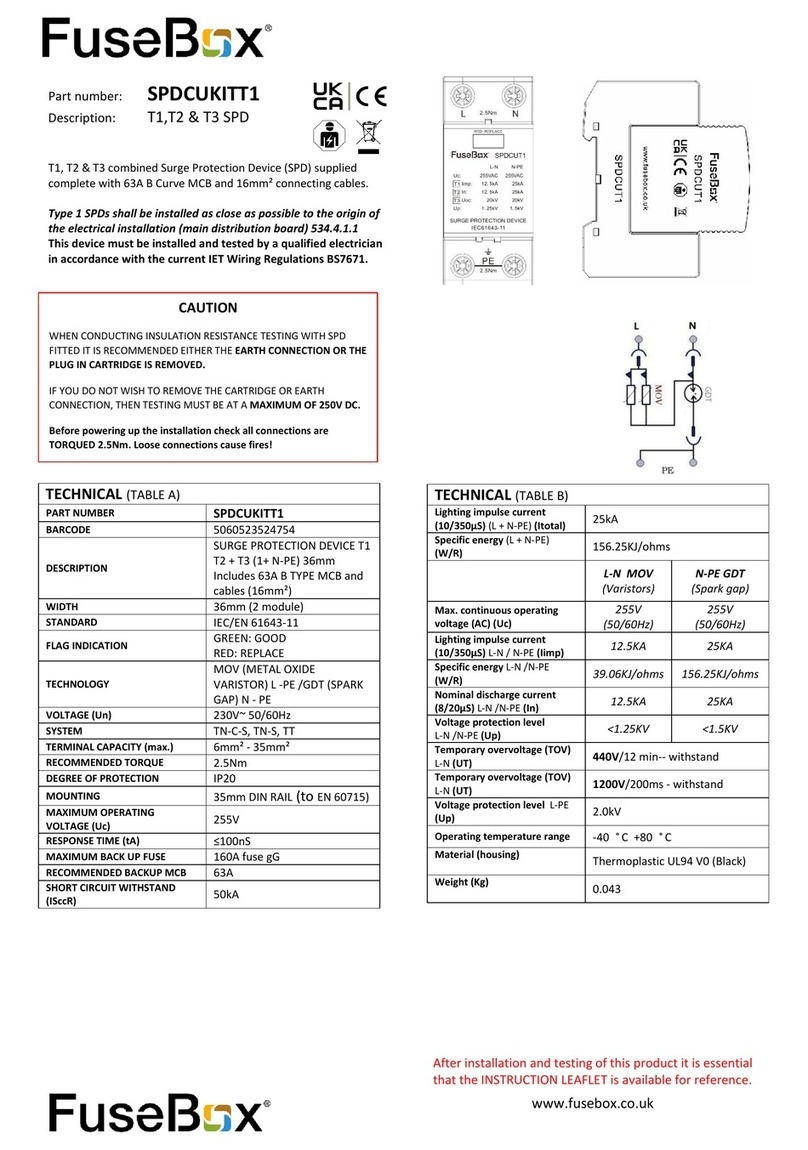
FuseBox
FuseBox SPDCUKITT1 quick start guide

ABB
ABB Relion REB500 Applications manual
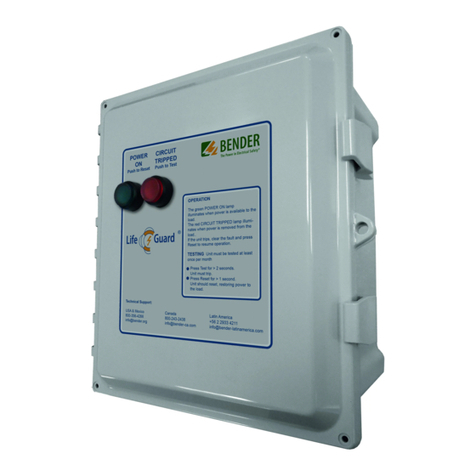
Bender
Bender LifeGuard LG2 Series quick start guide
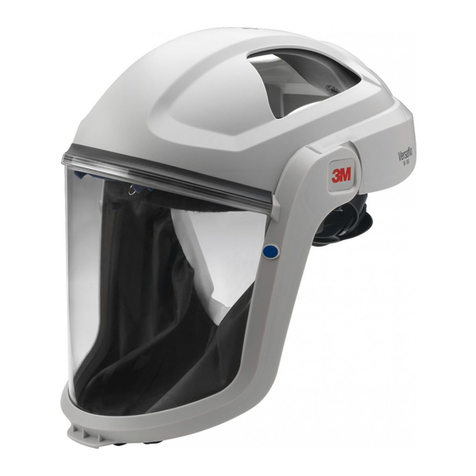
3M
3M Versaflo M Series User instructions
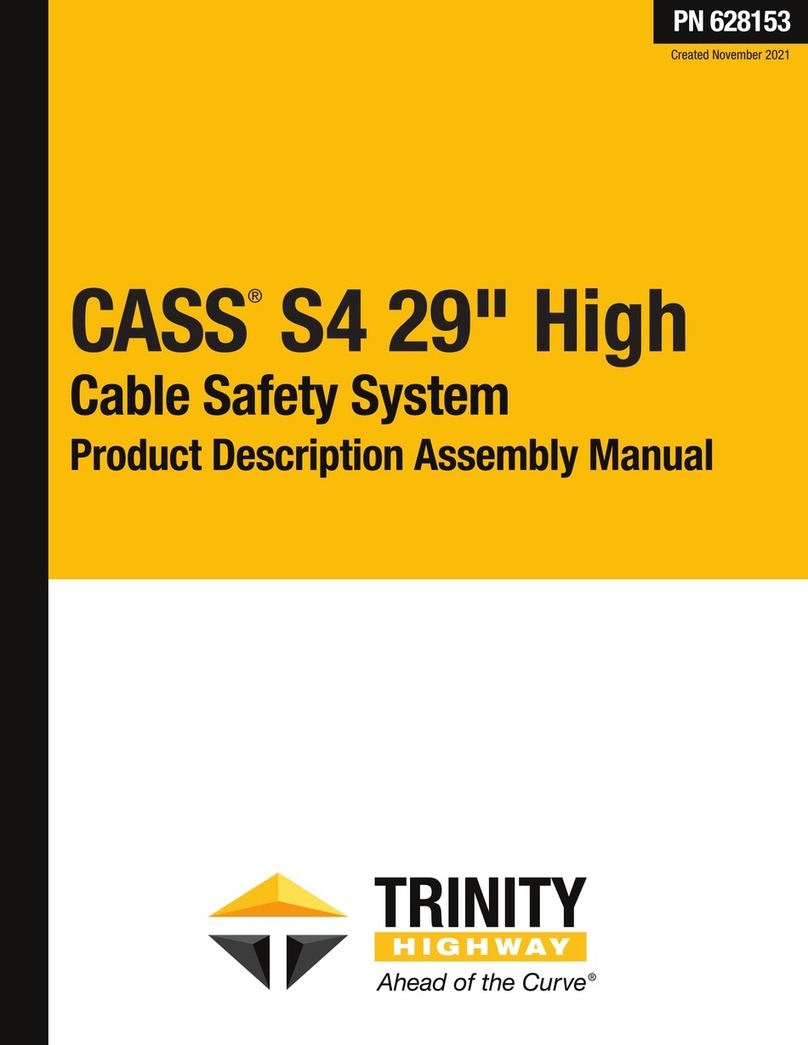
Curve
Curve TRINITI HIGHWAY CASS S4 Product Description Assembly Manual

Liftsafe Fall Protection
Liftsafe Fall Protection RoofGuard Classic HGC-KIT-09 User instruction guide

